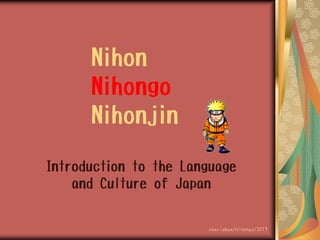
Japan: People, Language, and Culture
- 1. Nihon Nihongo Nihonjin Introduction to the Language and Culture of Japan charismae/nihongo/2013
- 2. population: 126,660,000 land area: 145,925 sq mi population: 98,734,798 land area: 115,831 sq mi charismae/nihongo/2013
- 3. Similarities and Differences Nihon Firipin East Asia Southeast Asia archipelago archipelago temperate climate tropical climate closed to foreign influences colonized by Spain, Japan, US charismae/nihongo/2013
- 5. The Writing System Nihon にほん ニホン 日本 “Roomaji” “Hiragana” “Katakana” “Kanji” charismae/nihongo/2013
- 9. あ ア a い イ i う ウ u え エ e お オ o か カ ka き キ ki く ク ku け ケ ke こ コ ko きゃ キャ きゅ キュ きょ キョ さ サ sa し シ shi す ス su せ セ se そ ソ so しゃ シャ しゅ シュ しょ ショ た タ ta ち チ chi つ ツ tsu て テ te と ト to ちゃ チャ ちゅ チュ ちょ チョ な ナ na に ニ ni ぬ ヌ nu ね ネ ne の ノ no にゃ ニャ にゅ ニュ にょ ニョ は ハ ha ひ ヒ hi ふ フ fu へ ヘ he ほ ホ ho ひゃ ヒャ ひゅ ヒュ ひょ ヒョ ま マ ma み ミ mi む ム mu め メ me も モ mo みゃ ミャ みゅ ミュ みょ ミョ りゃ リャ りゅ リュ りょ リョ や ヤ ya ら ラ ra わ ワ wa ゆ ユ yu り リ ri る ル ru を ヲ wo よ ヨ yo れ レ re ろ ロ ro ん ン n charismae/nihongo/2013
- 11. Kana vs. Kanji Kana are composed of Hiragana and Katakana. They represent SOUND. Kanji are derived from Chinese characters. They represent MEANING. charismae/nihongo/2013
- 13. Grammatical Structure I eat apples. Subject-Verb-Object Ako ay kumakain ng mansanas. Subject-Verb-Object Watashi wa ringo o tabemasu. Subject-Object-Verb charismae/nihongo/2013
- 15. Levels of Politeness itadakimasu / meshiagarimasu tabemasu taberu kuu charismae/nihongo/2013
- 17. Similarities and Differences Nihongo Firipingo 3 sets of characters (Kana and Kanji) consonant+vowel (Mora*) 1 set of characters (alpabeto) consonant+vowel (Pantig**) S-O-V S-V-O polite language polite language *except ‘n’ **not limited to this pattern charismae/nihongo/2013
